Welcome to my article on the perfect fruit to sugar ratio for jam making. If you’re a fan of homemade jam or looking to start making your own, you’ve come to the right place. Finding the ideal ratio of fruit to sugar is the secret to creating delicious, flavorful jams that will impress your friends and family.
When it comes to making jam, the fruit to sugar ratio is crucial. It determines not only the sweetness of the jam but also its texture. Too much sugar can overpower the natural flavors of the fruit, while too little can result in a jam that is too tart or runny. It’s important to strike the right balance to achieve a jam that is both sweet and spreadable.
Now, you may be wondering, how do you determine the perfect fruit to sugar ratio? Well, it depends on the fruit you’re using and your personal preference. Some fruits are naturally sweeter than others and require less sugar, while others may need a bit more to reach the desired sweetness. It’s all about finding the right balance.
Key Takeaways:
- The fruit to sugar ratio is crucial for making delicious homemade jam.
- Finding the right balance determines the sweetness and texture of the jam.
- Experiment with different ratios based on fruit sweetness and personal preference.
- Strike a balance between sweetness and spreadability for the perfect jam.
- The fruit to sugar ratio varies depending on the type of fruit used.
Benefits of Homemade Jam
When it comes to enjoying the goodness of fruit preserves, nothing beats homemade jam. Not only does it offer a burst of natural flavor, but it also provides several benefits that set it apart from store-bought alternatives.
Controlled Ingredients for a Healthier Option
One of the primary advantages of making your own jam is the ability to have full control over the ingredients. Store-bought options often contain artificial additives, excessive sugar, or preservatives that may not align with your dietary preferences or health goals. By preparing homemade jam, you can opt for organic fruits and use less sugar or natural sweeteners. This allows you to enjoy a more nutritious and wholesome jam that doesn’t compromise on flavor.
Preserving the Freshness of Seasonal Fruits
Homemade jam allows you to capture the vibrant flavors of seasonal fruits and savor them throughout the year. When fruits are in abundance, you can buy them at their peak and turn them into delightful jars of jam. This way, you can enjoy the taste of summer even during the colder months. Preserving the goodness of seasonal fruits not only adds variety to your pantry but also helps reduce food waste.
“Homemade jam is a wonderful way to showcase the flavors of seasonal fruits and enjoy them all year long.”
A Fresher and More Vibrant Flavor
Unlike its commercially made counterparts, homemade jam retains a fresher and more vibrant flavor. When you prepare jam in your own kitchen, you have the flexibility to experiment with different fruits, flavor combinations, and cooking techniques. This customization results in jams that are bursting with natural fruitiness and are tailored to your taste preferences. Whether you prefer a smooth strawberry jam or a chunky mixed berry preserve, the possibilities are endless.
| Jam Varieties | Description |
|---|---|
| Classic Strawberry Jam | A timeless favorite featuring sweet and tangy flavors. Perfect spread over warm buttered toast or as a filling for pastries. |
| Blueberry and Lemon Preserve | A delightful combination of bright blueberries and zesty lemon. Enjoy it with scones, pancakes, or as a topping for yogurt. |
| Raspberry and Vanilla Coulis | A luscious blend of tart raspberries and fragrant vanilla. Drizzle it over desserts or use it to elevate your ice cream sundae. |
| Peach and Ginger Conserve | A fusion of juicy peaches and spicy ginger that adds a unique twist to your morning toast or savory dishes like roasted chicken. |
The Science Behind Jam Making
Creating homemade jam involves a fascinating chemical process that transforms fresh fruits into delicious spreads. To understand this process, we need to explore the key elements: pectin, heat, sugar, and acid.
Pectin is a natural polysaccharide found in fruits, particularly in their skins, cores, and seeds. It acts as a gelling agent, giving jam its characteristic gel-like texture. When heated, the pectin molecules become soluble and form a mesh-like structure that traps liquid, resulting in the thick consistency we love.
Heat plays a vital role in jam-making. As we cook the fruit mixture, the pectin molecules react to the heat and start bonding together. This bonding process facilitates the creation of the gel-like texture we desire in our jam.
Sugar is not only responsible for adding sweetness to the jam but also contributes to its preservation. When sugar is added to the fruit mixture, it interacts with the pectin and helps to activate it further. The sugar also creates an unfavorable environment for bacteria growth, prolonging the shelf life of the jam.
Acid, often in the form of lemon juice, is crucial in the jam-making process. Acid helps to lower the pH level of the fruit, enhancing the pectin’s ability to form a gel. Additionally, acid acts as a natural preservative by inhibiting the growth of bacteria and ensuring the jam stays fresh for longer.
Understanding the science behind jam-making allows us to control the variables that affect the final product. By adjusting the pectin content, heat, sugar, and acid levels, we can achieve the perfect texture and set for our homemade jams.
The Role of Sugar in Jam Making
In the world of jam making, sugar plays a crucial role in creating that perfect balance of sweetness and preservation. Let’s delve into the various roles sugar plays in the jam-making process and explore healthier alternatives for those looking for options like low sugar jam or no added sugar jam recipes.
Sweetening the Fruit
One of the primary functions of sugar in jam making is to sweeten the fruit. Sugar enhances the natural flavors of the fruit, transforming them into a delectable spread that satisfies our taste buds. By adding sweetness, sugar helps strike the perfect balance in the jam, ensuring it’s enjoyable on toast, in desserts, or simply straight from the jar.
Preserving the Jam
Sugar acts as a natural preservative in jams, extending their shelf life and keeping them fresh for longer. The high sugar content creates an environment that inhibits the growth of microorganisms, including bacteria and molds, that could spoil the jam. This preservation property allows you to savor your homemade jam over an extended period.
Variations in Sugar Content
The amount of sugar used in jam making can vary depending on factors such as the sweetness of the fruit and personal preference. Some fruits, like strawberries or raspberries, are naturally sweeter and require less sugar. On the other hand, fruits with higher levels of acidity may require a bit more sugar to balance out the tartness. The freedom to adapt the sugar content allows for flexibility in creating healthier alternatives, such as low sugar jams or no added sugar jams.
Healthier Alternatives
Table: Alternative Sweeteners for Jam Making
| Alternative Sweetener | Description | Tastes Like |
|---|---|---|
| Stevia | A plant-based sweetener that is naturally low in calories and carbohydrates. | Similar to sugar, but with a slightly different aftertaste. |
| Agave Nectar | A natural sweetener derived from the agave plant. | Subtle and mildly sweet, with a flavor similar to honey. |
| Monk Fruit Sweetener | A non-nutritive sweetener made from the extract of monk fruit. | Sweet, with a flavor similar to sugar, without the calories. |
For those looking to reduce their sugar intake or avoid it altogether, there are various alternative sweeteners available. These sweeteners can be used in place of sugar to achieve a similar level of sweetness in jams. Some popular options include stevia, agave nectar, and monk fruit sweetener. Experimenting with these alternatives can provide you with a range of low sugar or no added sugar jam recipes.
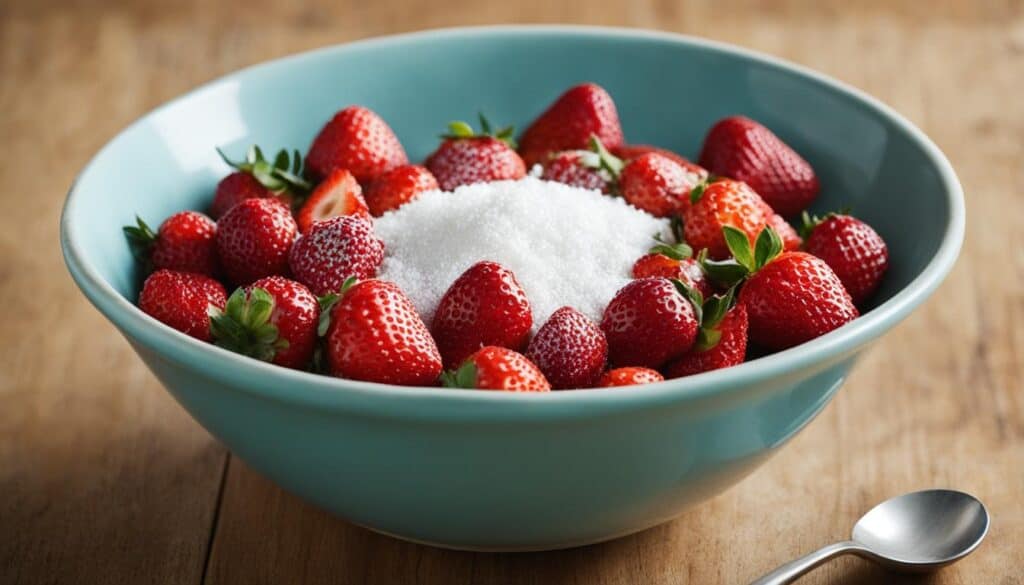
“Sugar plays a vital role in jam making, offering sweetness and acting as a natural preservative. However, with the rise in interest for healthier options, alternative sweeteners have emerged, providing opportunities for low sugar and no added sugar jam recipes.”
By understanding the role of sugar in jam making and exploring alternative sweeteners, you can create delicious and healthier jams that meet your dietary preferences. Whether you opt for traditional recipes or experiment with low sugar alternatives, the joy of homemade jam is all about finding that perfect balance of flavor and sweetness.
Acid in Jam Making
When it comes to making jam, acid plays a crucial role in achieving the perfect texture and flavor. One common form of acid used in jam making is lemon juice.
Lemon juice serves two important purposes in the jam-making process. Firstly, it helps activate the natural pectin present in the fruit. Pectin is a naturally occurring substance responsible for the gel-like consistency of jam. By adding acid such as lemon juice, we ensure the pectin works its magic and gives our jam that desired texture.
Furthermore, acid plays a vital role in preserving the jam and extending its shelf life. The lower pH level created by the acid inhibits the growth of bacteria, mold, and yeast, keeping your homemade jam fresh and safe to consume for longer periods.
It’s important to note that the amount of acid needed in jam making can vary based on the fruit being used. Fruits with naturally high acidity, such as citrus fruits, may require less additional acid. On the other hand, fruits with lower acidity may need a bit more lemon juice to achieve the desired pH level.
Overall, adding acid, particularly lemon juice, to your jam recipe is essential for achieving the perfect texture, enhancing the flavor, and ensuring a longer shelf life. Embrace the power of acid to create delicious and long-lasting homemade jams!
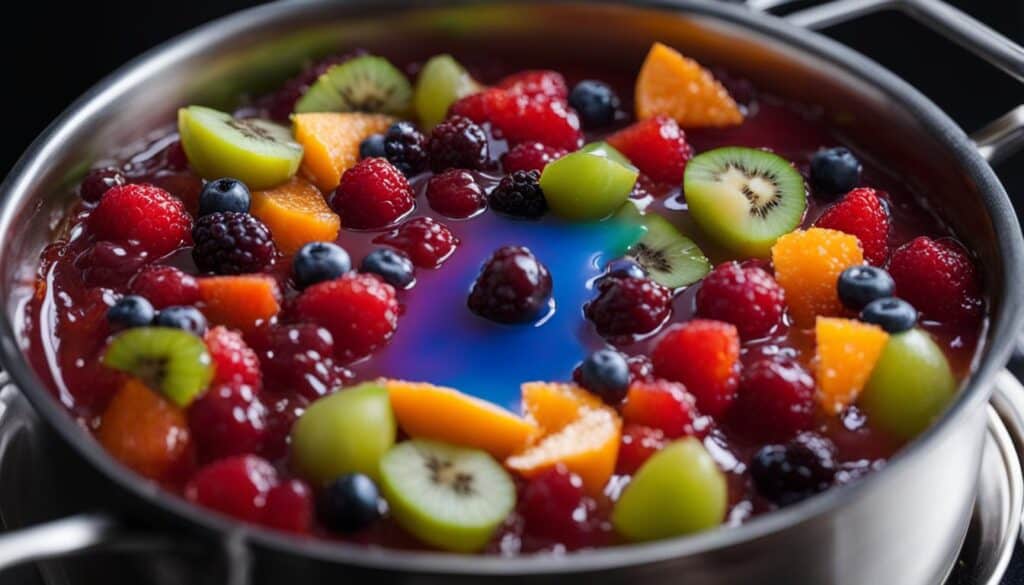
| Fruit | Recommended Acid (Lemon Juice) Amount |
|---|---|
| Strawberries | 1 tablespoon per 2 cups of strawberries |
| Raspberries | 1 tablespoon per 2 cups of raspberries |
| Blueberries | 1 tablespoon per 2 cups of blueberries |
| Peaches | 2 tablespoons per 2 cups of peaches |
Finding the Right Fruit to Sugar Ratio
When it comes to making delicious homemade jam, finding the perfect fruit to sugar ratio is key. This ratio determines not only the sweetness of the jam but also its overall flavor and texture. It’s important to strike the right balance between the natural sweetness of the fruit and the added sugar to create a jam that is both tasty and satisfying.
Different fruits have different levels of natural sweetness and pectin content, which affects how much sugar they require in the jam-making process. For example, berries are typically high in natural pectin and can create a set jam without the need for excessive amounts of sugar.
To achieve a low-calorie or healthier version of jam, it’s possible to experiment with reducing the amount of sugar used. This can be especially effective if you’re using fruits that are already naturally sweet. However, it’s important to note that reducing the sugar content can impact the set and shelf life of the jam.
It’s recommended to start with a standard fruit to sugar ratio and make adjustments based on taste preferences and the desired level of sweetness. Keep in mind that it may take a few batches to find the perfect ratio that works for you.
Tips for Finding the Right Fruit to Sugar Ratio:
- Start with a standard ratio of 1:1 (equal parts fruit and sugar) and adjust as needed.
- Consider the natural sweetness of the fruit and its pectin content when determining the amount of sugar to add.
- Reduce the amount of sugar for naturally sweet fruits or if you prefer a lower-calorie option.
- Experiment with different fruit to sugar ratios to find the perfect balance of flavor and sweetness.
Remember, the fruit to sugar ratio is not a rigid rule but rather a guideline that can be adjusted to suit your preferences. Don’t be afraid to get creative and find the combination that makes your homemade jam truly delightful.
“Finding the right fruit to sugar ratio is the secret to creating a perfectly balanced and flavorful jam.” – name
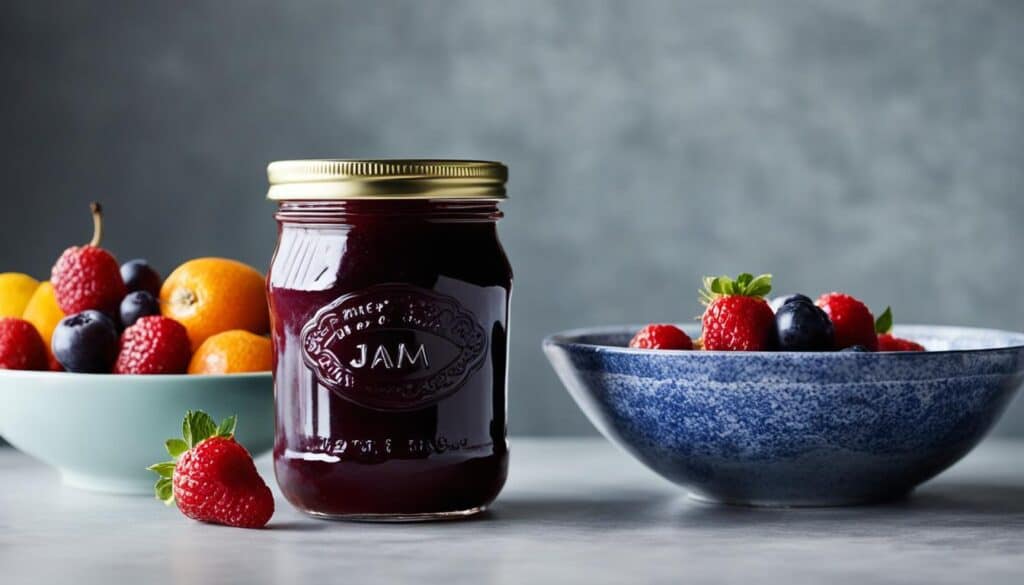
| Fruit | Sugar | Fruit to Sugar Ratio |
|---|---|---|
| Strawberries | 1 cup | 1:1 |
| Raspberries | 3/4 cup | 1:1.5 |
| Peaches | 1 1/4 cups | 1:1.25 |
| Blueberries | 1/2 cup | 1:2 |
Testing for the Gel Point
In order to achieve the perfect consistency and ensure that your jam sets properly, it is important to test for the gel point. The gel point is when the jam mixture reaches the desired thickness and texture, indicating that it is ready to be cooled and stored.
There are several methods that can be used to test for the gel point:
- Using an instant-read thermometer: Insert an instant-read thermometer into the jam mixture and wait for it to reach a temperature between 220°F and 222°F (104°C and 106°C). This temperature range indicates that the jam has reached the gel point.
- Performing the frozen-spoon test: Place a small plate or spoon in the freezer before you start making the jam. Once you think the jam may be ready, remove the plate or spoon from the freezer and drop a small amount of the hot jam mixture onto it. Allow it to cool for a few seconds, then gently push it with your fingertip. If the jam wrinkles and holds its shape, it has reached the gel point. If it is still runny, continue cooking and test again after a few minutes.
Testing for the gel point is crucial because it ensures that the jam has been cooked for the right amount of time, allowing it to properly set and achieve the desired consistency. Overcooking can result in a jam that is too thick and sticky, while undercooking can lead to a runny and watery texture.
By using these testing methods, you can confidently determine when your jam has reached the gel point and achieve the perfect consistency every time.
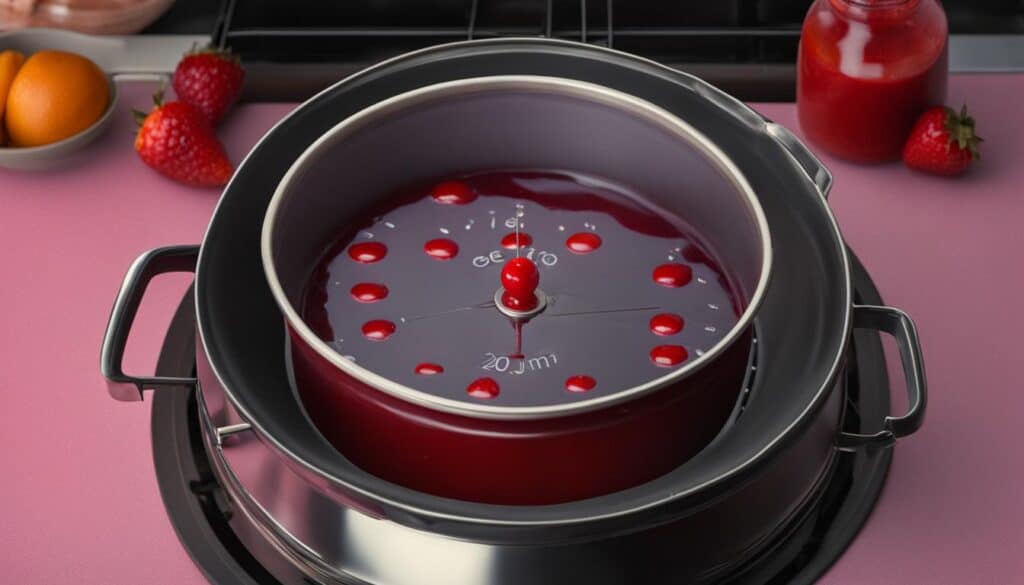
| Method | Description |
|---|---|
| Instant-read thermometer | Insert a thermometer into the jam to measure the temperature. The gel point is reached when the temperature reaches 220°F to 222°F (104°C to 106°C). |
| Frozen-spoon test | Place a small plate or spoon in the freezer. Drop a small amount of the hot jam mixture onto the frozen plate or spoon. If it wrinkles and holds its shape, the gel point has been reached. |
Alternative Ingredients for Jam Making
Jam making is not only delicious but also offers the opportunity to explore alternative ingredients that can enhance both flavor and health benefits. By replacing traditional granulated sugar with natural sweeteners and incorporating unique ingredients, you can create sugar-free jams and explore new dimensions of taste. Here are some alternative ingredients to consider:
Natural Sweeteners
Instead of using granulated sugar, you can experiment with natural sweeteners that add sweetness without the same glycemic impact. Some popular options include:
- Agave Syrup: Derived from the agave plant, this amber-colored syrup adds a subtle sweetness to your jams. It has a lower glycemic index compared to refined sugar and is a suitable choice for those looking to reduce their sugar intake.
- Coconut Blossom Sugar: Made from the sap of coconut blossoms, this natural sweetener offers a rich caramel flavor and adds depth to your jam. It has a lower glycemic index than white sugar and serves as an excellent alternative to traditional sweeteners.
Texture Enhancers
If you’re looking for ways to improve the texture of your jams or create unique flavors, consider incorporating these ingredients:
- Chia Seeds: These tiny seeds, when mixed with liquid, form a gel-like consistency that can help thicken your jam. Chia seeds also provide additional fiber and omega-3 fatty acids, making them a nutritious addition to your sugar-free jam.
- Agar Agar: Derived from seaweed, agar agar is a vegan gelatin substitute that can be used to give your jam a jelly-like texture. It is a versatile ingredient that can be found in powder or flakes form, offering a plant-based alternative without compromising on taste or texture.
Remember, when experimenting with alternative ingredients, it’s essential to adjust the quantities accordingly. The taste, texture, and sweetness levels may vary, so be prepared to adapt your recipes based on personal preference.
“Jam making allows for creativity and experimentation with alternative ingredients, opening up a world of possibilities for sugar-free and natural jams.” – Sophie Thompson
With these alternative ingredients, you can create unique and healthier jams that cater to different dietary needs and preferences. Explore the flavors and textures that these ingredients offer, and don’t be afraid to mix and match to develop your own signature jam recipes.
Alternative Ingredients for Sugar-Free Jam Making
| Natural Sweeteners | Benefits |
|---|---|
| Agave Syrup | – Lower glycemic index – Subtle sweetness |
| Coconut Blossom Sugar | – Rich caramel flavor – Lower glycemic index |
| Texture Enhancers | Benefits |
|---|---|
| Chia Seeds | – Thickening agent – Added fiber and omega-3 fatty acids |
| Agar Agar | – Vegan gelatin substitute – Creates jelly-like texture |
Tips for Making Homemade Jam
Making homemade jam can be a rewarding and enjoyable process. To ensure success, here are some valuable tips and techniques to keep in mind:
- Select ripe and quality fruits: The key to a flavorful jam is starting with ripe and high-quality fruits. Look for fruits that are fragrant, vibrant in color, and free from any bruises or blemishes.
- Use proper sterilized jars for storage: Before pouring your freshly made jam into jars, it’s essential to sterilize them. This process eliminates any bacteria that could spoil your jam and helps extend its shelf life.
- Adjust the cooking time based on the fruit’s pectin content: Different fruits contain varying levels of natural pectin, which affects the jam’s set and texture. Some fruits, like strawberries or peaches, have lower pectin content and may require longer cooking times to achieve the desired consistency.
- Be mindful of the gel point: The gel point is when the jam reaches the ideal consistency and sets properly. To determine the gel point, you can perform the frozen-spoon test or use a candy thermometer. This step ensures that your jam will have the perfect spreadable texture.
- Experiment with flavors and ratios: Don’t be afraid to get creative with your homemade jam. Experiment with different combinations of fruits, spices, and sweeteners to find your perfect recipe. Adjust the fruit to sugar ratio based on your preference for a sweeter or healthier option.
By following these tips, you’ll be well on your way to creating delicious homemade jam that you can enjoy and share with others.
Real-Life Example: The Importance of Sterilizing Jars
“I once made the most amazing batch of peach jam, only to discover later that I hadn’t properly sterilized the jars. The jam began to ferment and spoil within a week. Lesson learned! Now, I always take the time to sterilize my jars before adding the jam. It’s a small extra step that ensures my homemade jams stay fresh and delicious for months.”
– Sarah from The Jamming Kitchen
Recipes to Try with Homemade Jam
Homemade jam is a versatile ingredient that can elevate a variety of delicious recipes. Whether you want to enjoy a sweet breakfast or indulge in a decadent dessert, incorporating homemade jam adds a burst of flavor and a touch of homemade goodness. Here are some mouthwatering recipes to explore:
Jam-Filled Pancakes
Start your day with a stack of fluffy pancakes filled with your favorite homemade jam. Simply spread a layer of jam between each pancake and stack them high. The warm pancakes will melt the jam, creating a delightful breakfast treat. Top with a dollop of whipped cream or a dusting of powdered sugar for an extra touch of indulgence.
Scones with a Jam Swirl
Elevate your afternoon tea with homemade jam-filled scones. After shaping the scone dough into triangles, add a spoonful of jam to the center of each triangle. Then, gently fold the dough over the jam, creating a beautiful swirl. Bake the scones until golden brown and serve them warm with clotted cream or butter.
Jam-Filled Cookies
Add a delightful surprise to your favorite cookie recipe by incorporating homemade jam. Whether you prefer classic chocolate chip or buttery shortbread, these jam-filled cookies will take your recipe to the next level. Simply create a well in the center of each cookie dough ball, fill it with a small spoonful of jam, and bake as directed.
Jam-Filled Pastries
If you’re feeling adventurous, why not use homemade jam as a filling for pastries like Swiss rolls or babka? Roll out a sheet of puff pastry or yeasted dough, spread a generous layer of jam evenly, and tightly roll it into a log. Bake until golden and slice into beautiful swirls of jam-filled goodness.
Explore these recipes and let your creativity shine as you experiment with different flavors and combinations. From breakfast to dessert, homemade jam adds a touch of sweetness and a burst of flavor to any dish. Let your taste buds be your guide as you discover the endless possibilities of jam-filled treats.
Don’t forget to share your creations with friends and family. They will surely be impressed by the wonderful flavors you’ve infused into these irresistible homemade jam-filled desserts.
Conclusion
Creating delicious homemade jam is all about finding the perfect fruit to sugar ratio. By experimenting with different ratios and ingredients, you can customize your jam to suit your taste preferences and dietary needs.
One of the greatest benefits of making homemade jam is the ability to control the ingredients. Unlike store-bought options that often contain additives and preservatives, homemade jam allows you to enjoy natural and healthier fruit preserves. You can choose to make sugar-free jam or use alternative sweeteners to create a low-sugar option without compromising on flavor.
Aside from the control over ingredients, homemade jam also allows you to preserve the flavors of seasonal fruits. With a well-balanced fruit to sugar ratio, you can capture the essence of fresh fruits at their peak and enjoy them throughout the year. Imagine spreading a spoonful of your homemade raspberry jam on your morning toast, savoring the sweetness and vibrant taste that takes you right back to summer.
Don’t keep your homemade jam creations to yourself! Share the joy of natural, flavorful fruit preserves with your friends and family. Whether you gift a jar or host a gathering with a spread of jam-filled pastries, your loved ones will appreciate the care and effort you put into making homemade jam. So, get creative, explore new flavors, and embark on a delightful journey of homemade jam making!
FAQ
What is the perfect fruit to sugar ratio for jam making?
The perfect fruit to sugar ratio for jam making depends on the fruit’s natural sweetness, pectin content, and desired level of sweetness. Some fruits require less sugar due to their higher natural pectin content. It’s important to experiment and adjust the ratio to find the perfect balance of flavor and sweetness.
What are the benefits of homemade jam?
Homemade jam offers several benefits compared to store-bought alternatives. It allows you to control the ingredients, ensuring a more natural and healthy option. It also allows you to preserve seasonal fruits and enjoy them throughout the year. Additionally, homemade jam often has a fresher and more vibrant flavor compared to commercially made options.
What is the science behind jam making?
Jam-making involves a fascinating chemical process. Pectin, a polysaccharide found in fruit, is responsible for creating the gel-like texture in jam. Heat, sugar, and acid all work together to activate the pectin and form the desired consistency. Understanding the science behind jam-making can help you achieve the perfect texture and set.
What is the role of sugar in jam making?
Sugar plays multiple roles in jam making. It sweetens the fruit and acts as a preservative, extending the shelf life of the jam. The amount of sugar used can vary depending on the sweetness of the fruit and personal preference. Some recipes allow for lower sugar or no added sugar options, creating healthier alternatives to traditional jams.
Why is acid important in jam making?
Acid, often in the form of lemon juice, is essential in jam making. It helps activate the pectin and create the gel-like texture. Acid also lowers the pH level of the jam, inhibiting the growth of bacteria and extending its shelf life. The amount of acid needed can vary based on the fruit being used.
How do I find the right fruit to sugar ratio?
The ideal fruit to sugar ratio in jam making depends on the fruit’s natural sweetness, pectin content, and desired level of sweetness. Some fruits, like berries, have a higher natural pectin content and require less sugar. It is important to experiment and adjust the ratio to find the perfect balance of flavor and sweetness.
How do I test for the gel point in jam making?
The gel point is when the jam mixture reaches the desired consistency and sets properly. Achieving the gel point can be determined by various methods, such as using an instant-read thermometer or performing the frozen-spoon test. These tests help ensure that the jam is properly cooked and will set correctly when cooled.
Can I use alternative ingredients in jam making?
Yes, jam making allows for creativity and experimentation with alternative ingredients. Various natural sweeteners, such as agave syrup or coconut blossom sugar, can be used instead of traditional granulated sugar. Other ingredients, like chia seeds or agar agar, can also be added to enhance texture and create unique flavors in sugar-free or low-sugar jams.
What are some tips for making homemade jam?
To ensure success in making homemade jam, consider selecting ripe and quality fruits, using proper sterilized jars for storage, adjusting the cooking time based on the fruit’s pectin content, and being mindful of the gel point. Experiment with flavors and ratios to find your perfect homemade jam recipe.
What recipes can I try with homemade jam?
Homemade jam can be used in a variety of delicious recipes. Consider trying jam-filled pancakes, scones, cookies, or even using it as a filling for pastries like Swiss rolls or babka. The possibilities are endless, and homemade jam adds a burst of flavor to any dessert or baked good.

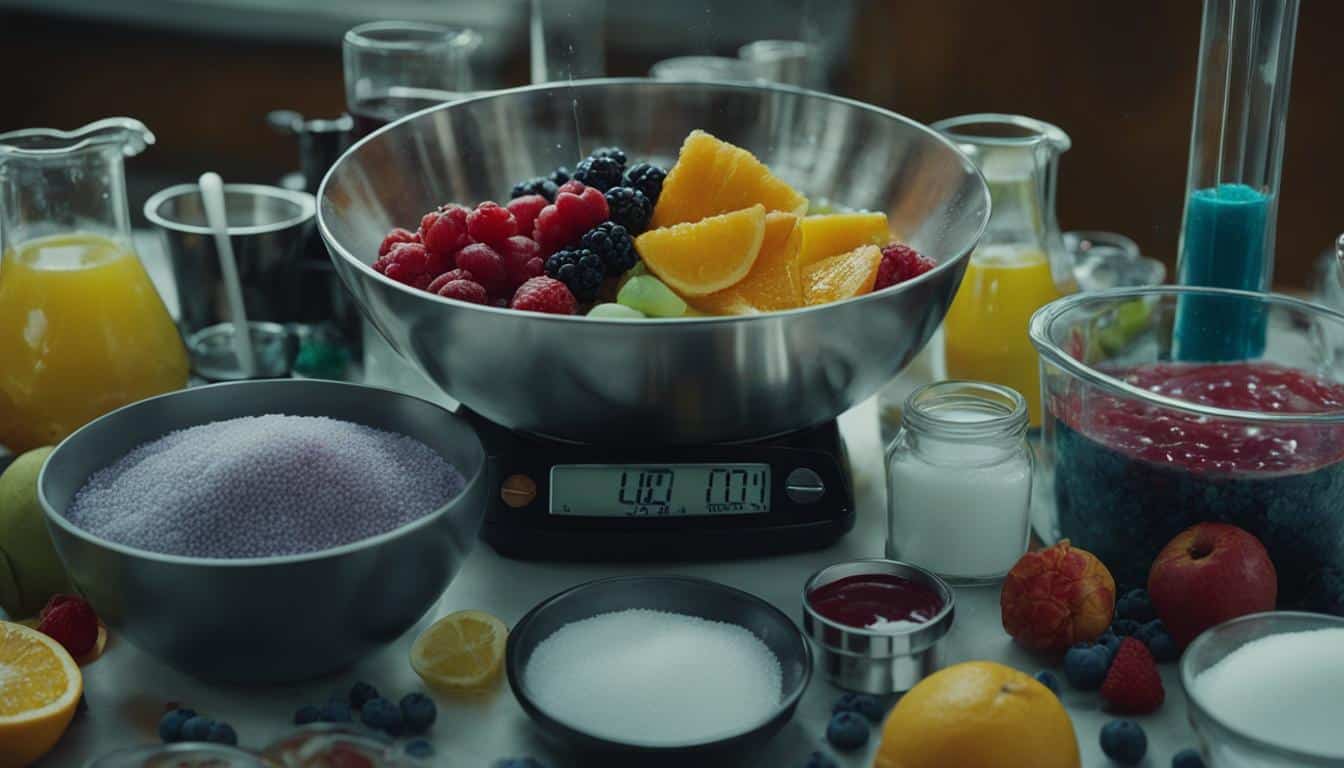



Leave a Reply